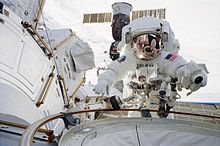
Malcolm Scott Carpenter was an American naval officer and aviator, test pilot, aeronautical engineer, astronaut and aquanaut. He was one of the Mercury Seven astronauts selected for NASA's Project Mercury in April 1959. Carpenter was the second American to orbit the Earth and the fourth American in space, after Alan Shepard, Gus Grissom and Glenn.

Walter Marty Schirra Jr. was an American naval aviator, test pilot, and NASA astronaut. In 1959, he became one of the original seven astronauts chosen for Project Mercury, which was the United States' first effort to put humans into space. On October 3, 1962, he flew the six-orbit, nine-hour, Mercury-Atlas 8 mission, in a spacecraft he nicknamed Sigma 7, becoming the fifth American and ninth human to travel into space. In December 1965, as part of the two-man Gemini program, he achieved the first space rendezvous, station-keeping his Gemini 6A spacecraft within 1 foot (30 cm) of the sister Gemini 7 spacecraft. In October 1968, he commanded Apollo 7, an 11-day low Earth orbit shakedown test of the three-man Apollo Command/Service Module and the first crewed launch for the Apollo program.
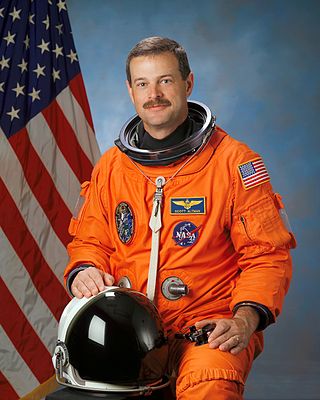
Scott Douglas "Scooter" Altman is a retired United States Navy Captain and naval aviator, engineer, test pilot and former NASA astronaut. He is a veteran of four Space Shuttle missions. His fourth mission on STS-125 was the last servicing mission to the Hubble Space Telescope. As of November 2022, he is the president of the Space operating group for ASRC Federal.

Michael López-Alegría is an astronaut, test pilot and commercial astronaut with dual nationality, American and Spanish; a veteran of three Space Shuttle missions and one International Space Station mission. He is known for having performed ten spacewalks so far in his career, presently holding the second longest all-time EVA duration record and having the fifth-longest spaceflight of any American at the length of 215 days; this time was spent on board the ISS from September 18, 2006, to April 21, 2007. López-Alegría commanded Axiom-1, the first ever all-private team of commercial astronaut mission to the International Space Station, which launched on April 8, 2022, and spent just over 17 days in Earth's orbit.

Jeffrey Shears Ashby is an American mechanical engineer, and former naval officer and aviator, test pilot and NASA astronaut, a veteran of three Space Shuttle missions. He is a retired Captain in the U.S. Navy. He currently works for Blue Origin as chief of mission assurance.
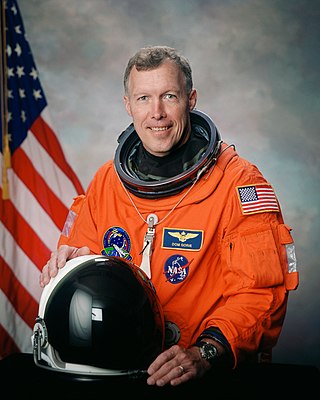
Dominic Lee Pudwill Gorie is a retired United States Navy officer and NASA astronaut. He is a veteran of four Space Shuttle missions.

Dale Allan Gardner was a NASA astronaut, and naval flight officer who flew two Space Shuttle missions during the mid 1980s.
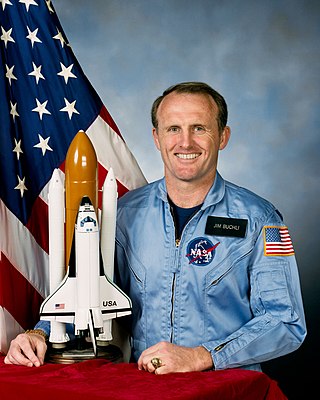
James Frederick Buchli is a retired United States Marine aviator and former NASA astronaut who flew on four Space Shuttle missions.
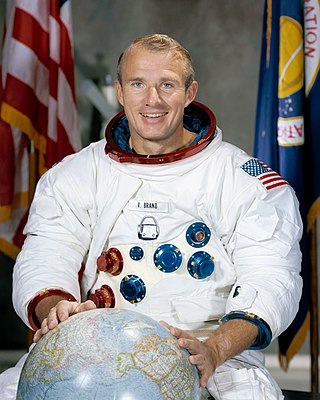
Vance DeVoe Brand is an American naval officer, aviator, aeronautical engineer, test pilot, and NASA astronaut. He served as command module pilot during the first U.S.-Soviet joint spaceflight in 1975, and as commander of three Space Shuttle missions.

Kent Vernon "Rommel" Rominger is an American former astronaut, former NASA Chief of the Astronaut Office at Johnson Space Center, and a captain in the United States Navy. Rominger holds the Space Shuttle Orbiter flight time record with 1610 hours. He joined ATK Launch Systems Group in 2006 as Vice President of Advanced Programs.

Robert Lee "Hoot" Gibson, , is a former American naval officer and aviator, test pilot, and aeronautical engineer. A retired NASA astronaut, he also served as Chief of the Astronaut Office from 1992 to 1994. Today Gibson is active as a professional pilot, racing regularly at the annual Reno Air Races. He was inducted into the U.S. Astronaut Hall of Fame in 2003 and the National Aviation Hall of Fame in 2013, and has received several military decorations throughout his career.

Kathryn Patricia "Kay" Hire is a former NASA astronaut and Captain in the U.S. Navy Reserve who has flown aboard two Space Shuttle missions.

Ronald Michael "Ron" Sega is an American former astronaut who is professor of systems engineering and Vice President for Energy and the Environment at the Colorado State University Research Foundation, a non-profit advocacy organization supporting CSU. He is also the Vice President and Enterprise Executive for Energy and Environment at Ohio State University. From August 2005 to August 2007, he served as Under Secretary of the Air Force. He is a retired major general in the United States Air Force and a former NASA astronaut. Sega was born in Cleveland, Ohio, he is of Slovene origin. He was married to fellow astronaut Bonnie J. Dunbar. He is now married to Ann Sega and they have two sons. He has lived in both Northfield, Ohio and Colorado Springs.

Rex Joseph Walheim is a retired United States Air Force officer, engineer and NASA astronaut. He flew three Space Shuttle missions, STS-110, STS-122, and STS-135. Walheim logged over 566 hours in space, including 36 hours and 23 minutes of spacewalk (EVA) time. He was assigned as mission specialist and flight engineer on STS-135, the final Space Shuttle mission.

Timothy Lennart "Tim" Kopra is an engineer, a Colonel in the United States Army and a retired NASA astronaut. He served aboard the International Space Station as a flight engineer for Expedition 20, returning to Earth aboard Space Shuttle Discovery on the STS-128 mission on September 11, 2009. He returned to the ISS for the second time in December 2015, as part of Expedition 46 and as the commander of 47.
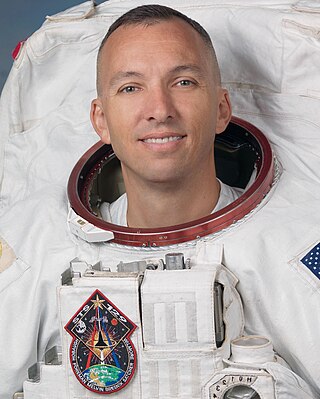
Randolph James "Komrade" Bresnik is a retired officer in the United States Marine Corps and an active NASA astronaut. A Marine Aviator by trade, Bresnik was selected as a member of NASA Astronaut Group 19 in May 2004. He first launched to space on STS-129, then served as flight engineer for Expedition 52, and as ISS commander for Expedition 53.

Gregory Reid Wiseman is an American astronaut, engineer, and naval aviator. He served as Chief of the Astronaut Office until November 14, 2022.

Karen Kohanowich is a retired U.S. Naval officer and ocean research and technology program manager for the National Oceanic and Atmospheric Administration (NOAA)'s Office of Ocean Exploration and Research (OER). She was NOAA's Acting Director of the National Undersea Research Program (NURP) from 2006 to 2009, and served in various roles at OER, including Acting Deputy and Undersea Technology director, until retiring in 2018. In July 2006, she became an aquanaut on the NASA Extreme Environment Mission Operations 10 crew.

Kenneth Stanley Reightler Jr. is a former NASA astronaut.

Matthew Stuart Dominick is a US Navy test pilot and NASA astronaut. He has more than 1,600 hours of flight time in 28 aircraft, 400 carrier-arrested landings, 61 combat missions, and almost 200 flight test carrier landings. He is currently on the ISS aboard the SpaceX Crew-8 mission.


